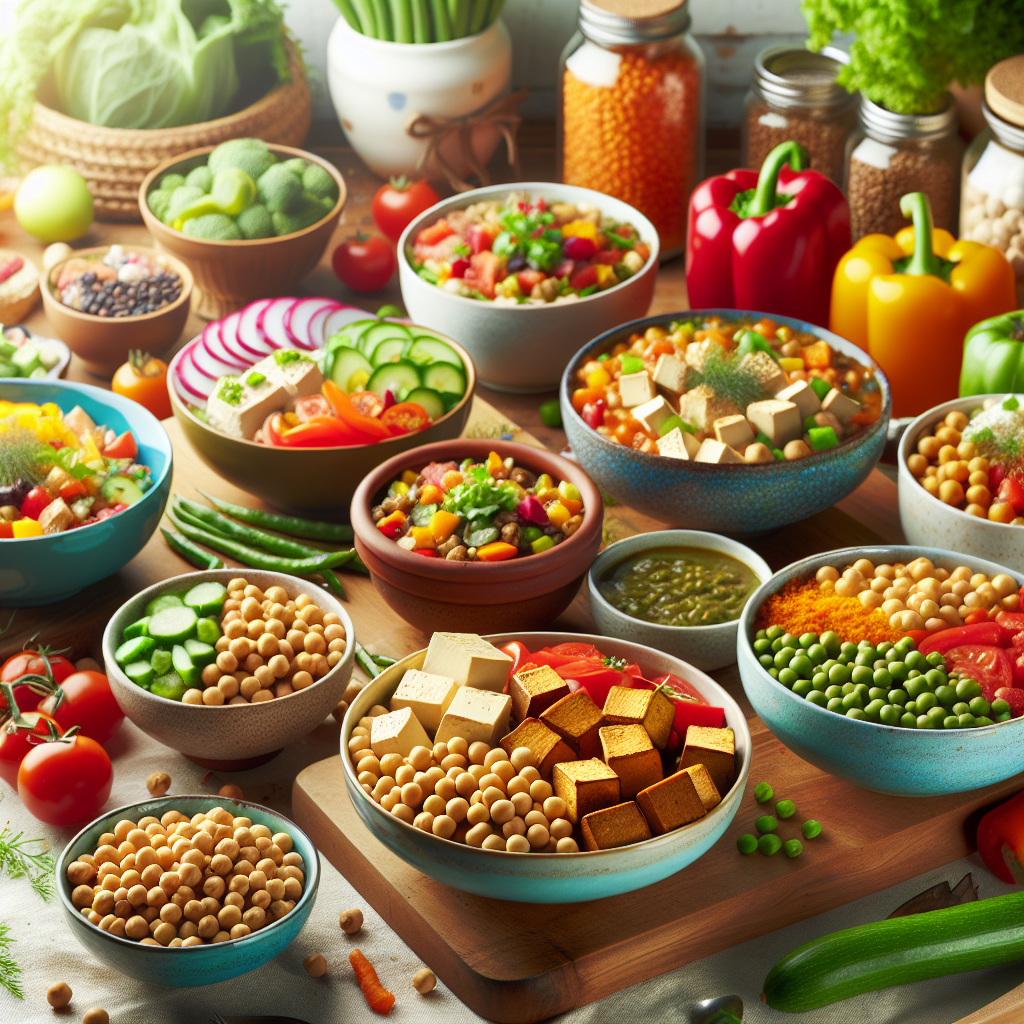I Tried TikTok’s Viral High-Protein Vegan Meals: Are They Worth the Hype?
By Plant Based News | Updated June 2024
Introduction: Why Are High-Protein Vegan Meals Trending on TikTok?
In the ever-evolving world of social media, TikTok has emerged as a powerful platform for food trends, especially among Gen Z and Millennials. One of the latest crazes is high-protein vegan meals, with creators sharing colorful, creative, and protein-packed recipes that promise to fuel your day and satisfy your taste buds. But do these viral recipes live up to the hype? Are they suitable for people with food sensitivities and specific dietary preferences? And how can you ensure you’re making choices that are both delicious and safe for your unique needs? We put TikTok’s most popular high-protein vegan meals to the test and explored how tools like Food Scan Genius are revolutionizing meal planning for everyone.
What Are TikTok’s Viral High-Protein Vegan Meals?
TikTok’s viral high-protein vegan meals are recipes that prioritize plant-based protein sources such as tofu, tempeh, lentils, beans, seitan, and vegan protein powders. These meals are designed not only to meet the protein needs of vegans and vegetarians but also to appeal to flexitarians and anyone looking to reduce their meat consumption.
Some of the most popular recipes include:
- Vegan “Chicken” Caesar Wraps with marinated tofu or seitan
- Protein-Packed Lentil Pasta Bowls
- Chickpea Omelets and Scrambles
- High-Protein Overnight Oats with pea or soy protein
- Edamame and Quinoa Buddha Bowls
- Tempeh Stir-Fries with nut-based sauces
These dishes are not only visually appealing but also easy to prepare, making them ideal for busy lifestyles and meal preppers.
My Experience: Testing TikTok’s High-Protein Vegan Recipes
As a plant-based journalist with a keen interest in nutrition, I spent a week preparing and tasting a selection of TikTok’s most viral high-protein vegan meals. My goal was to assess their flavor, ease of preparation, nutritional value, and suitability for people with food sensitivities.
Day 1: Vegan “Chicken” Caesar Wrap
Using marinated tofu, a homemade cashew Caesar dressing, and whole-grain wraps, this meal was both satisfying and packed with flavor. The tofu provided a solid protein punch (about 20g per serving), and the creamy dressing was a hit.
Day 2: Lentil Pasta Bowl
Lentil pasta is a game-changer for those seeking gluten-free and high-protein options. Paired with roasted vegetables and a tahini-lemon sauce, this bowl delivered over 25g of protein per serving and kept me full for hours.
Day 3: Chickpea Omelet
Chickpea flour, nutritional yeast, and black salt created a surprisingly eggy flavor. I added spinach, tomatoes, and red onion for extra nutrients. This meal is naturally soy-free and nut-free, making it perfect for those with common allergies.
Day 4: High-Protein Overnight Oats
By mixing rolled oats with pea protein powder, almond milk, chia seeds, and berries, I created a breakfast that boasted 18g of protein and plenty of fiber. This recipe is easily adaptable for nut-free or gluten-free diets.
Day 5: Tempeh Stir-Fry
Tempeh is a fermented soy product rich in protein and probiotics. I stir-fried it with broccoli, bell peppers, and a peanut-ginger sauce. For those with peanut allergies, sunflower seed butter is a great alternative.
Day 6: Edamame and Quinoa Buddha Bowl
This bowl combined edamame, quinoa, shredded carrots, purple cabbage, and a sesame-tamari dressing. It was vibrant, protein-rich (about 22g per serving), and easy to customize for various dietary needs.
Day 7: Recap and Reflections
Overall, I was impressed by the variety, taste, and nutritional profiles of these meals. They were quick to make, budget-friendly, and easily adaptable for different dietary restrictions.
Nutrition Analysis: Are TikTok’s Vegan Meals Really High-Protein?
According to the latest research published in 2024, plant-based diets can provide adequate protein when diverse sources are included. The recommended daily protein intake for adults is 0.8–1.0g per kilogram of body weight, but athletes and active individuals may require more. Many TikTok recipes deliver 15–30g of protein per serving, which is comparable to traditional animal-based meals.
Key protein sources featured in viral recipes include:
- Tofu and Tempeh: 15–20g protein per 100g
- Lentils and Beans: 8–12g protein per 100g cooked
- Seitan: 20–25g protein per 100g (not suitable for gluten sensitivities)
- Vegan Protein Powders: 15–25g protein per scoop
- Quinoa: 4g protein per 100g cooked
- Edamame: 11g protein per 100g
These ingredients not only boost protein but also provide essential amino acids, fiber, vitamins, and minerals.
Food Sensitivities and Dietary Preferences: What You Need to Know
While TikTok’s high-protein vegan meals are innovative, not all recipes are suitable for everyone. Many people have food sensitivities or allergies to soy, gluten, nuts, or legumes. According to a 2023 study in Frontiers in Nutrition, up to 20% of adults report some form of food intolerance or allergy, highlighting the importance of ingredient awareness.
Here’s how to adapt popular recipes for common food sensitivities:
- Soy-Free: Use chickpeas, lentils, or pea protein instead of tofu or tempeh.
- Gluten-Free: Choose lentil, chickpea, or brown rice pasta instead of seitan or wheat-based products.
- Nut-Free: Substitute sunflower seed butter or tahini for nut-based sauces.
- Legume-Free: Use quinoa, hemp seeds, or pumpkin seeds as protein sources.
Always check ingredient labels and be mindful of cross-contamination if you have severe allergies.
How Food Scan Genius Empowers People With Food Sensitivities
Navigating food sensitivities and dietary preferences can be overwhelming, especially with the sheer volume of recipes circulating on TikTok and other platforms. This is where Food Scan Genius comes in. Food Scan Genius is an innovative app that allows users to scan recipes, product barcodes, or ingredient lists and instantly receive tailored information based on their unique dietary needs.
- Personalized Alerts: Instantly flags allergens or ingredients you want to avoid.
- Alternative Suggestions: Recommends safe, nutritious swaps for common allergens.
- Nutrition Breakdown: Provides a detailed analysis of protein, vitamins, minerals, and more.
- Meal Planning Integration: Helps you build weekly meal plans with safe, high-protein vegan options.
For anyone inspired by TikTok’s viral recipes but concerned about food sensitivities, Food Scan Genius is a game-changer. It empowers users to enjoy creative, protein-rich meals with confidence.
Expert Tips for Creating High-Protein Vegan Meals at Home
Want to make your own high-protein vegan meals? Here are some evidence-based tips:
- Mix Your Protein Sources: Combine legumes, grains, seeds, and nuts for a complete amino acid profile.
- Use Protein Powders Wisely: Opt for clean, additive-free vegan protein powders to boost smoothies, oats, and baked goods.
- Batch Cook: Prepare large portions of beans, lentils, or tofu to use in multiple meals throughout the week.
- Incorporate Fermented Foods: Tempeh and miso not only add protein but also support gut health.
- Don’t Forget Micronutrients: Ensure adequate intake of B12, iron, zinc, and omega-3s through fortified foods or supplements.
- Adapt for Sensitivities: Always substitute ingredients to fit your dietary needs—Food Scan Genius can help!
Frequently Asked Questions (FAQs)
- Are high-protein vegan meals suitable for athletes?
- Yes! Recent research (2024) shows that plant-based athletes can meet their protein needs with careful planning and diverse sources. Many TikTok recipes offer 20g+ protein per serving.
- Can I make these meals gluten-free?
- Absolutely. Use gluten-free grains, pastas, and avoid seitan. Always check labels for hidden gluten.
- How can I avoid allergens in viral recipes?
- Substitute ingredients as needed and use tools like Food Scan Genius to scan for allergens and safe alternatives.
- Do plant-based proteins provide all essential amino acids?
- Yes, when you eat a variety of protein sources (legumes, grains, seeds), you’ll get all essential amino acids.
Conclusion: Are TikTok’s Viral High-Protein Vegan Meals Worth Trying?
After a week of testing and researching, it’s clear that TikTok’s viral high-protein vegan meals are more than just a passing fad. They’re delicious, easy to prepare, and nutritionally robust—especially when you tailor them to your personal dietary needs. With the support of modern tools like Food Scan Genius, anyone can enjoy these creative recipes while managing food sensitivities and preferences.
Whether you’re a seasoned vegan, a flexitarian, or simply curious about plant-based eating, these meals offer a convenient and satisfying way to boost your protein intake. Just remember to adapt recipes as needed, stay informed about your nutritional needs, and leverage technology to make meal planning safer and easier than ever.
References






